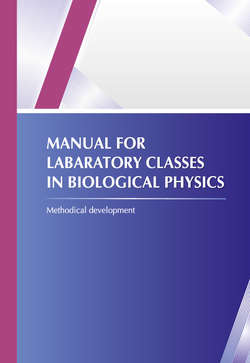Manual for laboratory classes in biological physics

Реклама. ООО «ЛитРес», ИНН: 7719571260.
Оглавление
Коллектив авторов. Manual for laboratory classes in biological physics
FOREWORD
SAFETY REQUIREMENTS DURING BIOPHYSICS WORKSHOPS
Chapter 1. THERMODYNAMICS
Laboratory work № 1. Determination of temperature coefficient and calculation of the activation energy of the frog’s heart
Laboratory work № 2. Determination of the temperature coefficient and calculation of the action energy of respiration of elodea plant branch
Chapter 2. WORKING PRINCIPLE OF PH-SENSOR
Laboratory work № 3. pH of various solutions and biological liquids
`Laboratory work № 4. Determination of pH of fermented milk products using a pH meter
Chapter 3. BUFFER PROPERTIES AND BUFFER CAPACITY OF BIOLOGICAL LIQUIDS
Laboratory work № 5. Definition of alkaline and acid buffers of serum blood
Laboratory work № 6. Buffer capacities of biological liquids
Chapter 4. THE OXYGEN CONTENT IN WATER
Laboratory work № 7. Determination of the oxygen content dissolved in water
Laboratory work № 8. Amperometric method of determining the rate of respiration of aquatic plants and yeast cells
Laboratory work № 9. Study of electrical parameters of the solutions and wash water of seeds
Chapter 5. PHOTOMETRIC METHODS OF BIOLOGICAL SYSTEM’S RESERCH
Laboratory work№ 10. Working principle of photoelectrocolorimeter
Laboratory work № 11. Measurement of optical density of different solutions
Laboratory work № 12. The method of vital staining of tissues
Laboratory work № 13. Studying of sorption of dyes by bio objects depending on the action of various physical factors
Laboratory work № 14. Water sorption studying by fabrics depending on action of various physical factors
Laboratory work № 15. Spectrophotometer
Chapter 6. OPTICAL PROPERTIES OF BLOOD
Laboratory work № 16. Effects of different chemicals on the light scattering and light absorption of hemoglobin solution
Laboratory work № 17. The study of photodynamical hemolysis of erythrocytes
Chapter 7. POLARIMETRY
Laboratory work № 18. Sugar concentration measurements by the polarimeter SU-4
Chapter 8. LASERS IN BIOLOGY AND MEDICINE
Laboratory work № 19. Working principle of laser
Laboratory work № 20. Study of the properties of natural light and artificial light sources
Chapter 9. ELECTROCONDUCTIVITY OF LIVING SYSTEMS
Laboratory work № 21. The study of the laws of the passage of an electric current through living tissue
Laboratory work № 22. Galvanizing. Electrophoresis of drugs
Chapter 10. BIOLOGICALLY ACTIVE POINTS OF HUMAN AND ANIMAL SKIN
Laboratory work № 23. The study of biophysical parameters of biologically active points of human skin
Chapter 11. ELECTROCARDIOGRAPHY
Laboratory work № 24. The study of human electrocardiogram during exercise
Laboratory work № 25. Construction of the electrical axis of the heart
Chapter 12. GALVANIC SKIN RESPONSE
Laboratory work № 26. The study of human’ galvanic skin response
APPLICATION
Textbook & Course Materials
Отрывок из книги
Before carrying out any laboratory work, students are required to undergo safety training. The students will also have to sign the control sheets that indicate completion of the training.
During labs, instruments that meet standard requirements and have proper technical specifications and normative technical documentation could be used. The equipment is checked directly by the instructor before the laboratory.
.....
1. Count the amount of gas bubbles at room temperature;
2. Count the amount of gas bubbles during the rise of the temperature by 10 °C;
.....